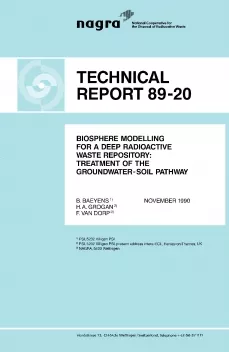
Technical Report NTB 89-20
Biosphere modelling for a deep radioactive waste repository:Treatment of the groundwater-soil pathway
The effect of radionuclide transfer from near-surface groundwater to the rooting zone soil, via a deep soil layer, is modelled in this report. The possible extent of upward solute movement is evaluated for a region in northern Switzerland.
The concentrations of 237Np and 129I in the deep and top soil, and hence growing crops, are evaluated assuming a constant unit activity concentration in the groundwater. A number of parameter variations are considered, namely variable soil sorption coefficients, reduced infiltration of rain water and decreased groundwater flow. A release to an alternative smaller recipient region in northern Switzerland is also evaluated. For the parameter ranges considered uncertainty in the solid-liquid distribution coefficient has the largest effect on overall uncertainty.
These calculations have been presented within the international Biosphere Model Validation Study (BIOMOVS). A description of the test scenario, and the model calculations submitted, has been included in this report for completeness.
To place the groundwater – soil – crop – man pathway in context, its contribution to the total dose to man is evaluated for the 237Np – 233U – 229Th decay chain. The results obtained using the two-layer soil model, described in this report, are compared with the single-layer soil model used during Project Gewähr 1985. The more realistic two-layer soil model indicated an increase in importance of the drinking water pathway. It should be noted, however, that not all the critical pathways have been treated in this study with the same degree of conservatism.
